Random Reviews: Pitt (vol. 1)
Dale Keown's Image contribution should hold up better than it does, well-constructed panels surpassing the strengths of the narrative
—by Nathan on April 29, 2024—
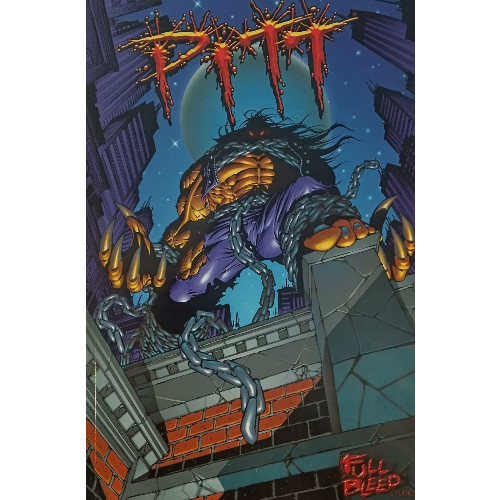
Over the last few months, I periodically reviewed volumes containing the first issues of each of the seven series Image Comics originally published after they were founded–Rob Liefeld's Youngblood, Todd McFarlane's Spawn, Erik Larson's Savage Dragon, Jim Lee's WildC.A.T.S., Jim Valentino's ShadowHawk, Marc Silvestri's Cyberforce, and Whilce Portacio's Wetworks. The exercise, as I attested to multiple times, was a struggle. The thrill I felt when I first pictured diving into the birth of a new comics universe petered out very quickly.
Yet, for some reason, I'm back.
This review is not, as I noted in my Wetworks review, a continuation of "The Image Review-lution." That series within a series was intended to solely focus on the seven titles started by Image's founding fathers. In the time since, I've collected some other volumes showcasing other series by creators welcomed into the Image fold. Yes, this may end up being a foolish decision on my behalf, and I may once again spiral into bemoaning my choices, but some part of me just remained curious. What else did early Image offer? I wondered. Who else collaborated with these seven creators? What series did they kick off? What stories did they create?
So even as I explore stories crafted by other studios, I will return, as time allows, to the sheep fold, shepherding these reviews on ahead and examining the sundry samples of creative talent (or "talent"?) which issued forth. Like my other reviews, I don't believe this will be an easy or largely enjoyable task, but hey, I'm ready to be surprised. I want to be surprised. Maybe that's why I keep coming back to the pit(t).
Pitt (vol. 1)
Writers: Dale Keown, Brian Hotton
Penciler: Dale Keown
Inkers: Dale Keown, Joe Rubenstein, Scott Williams
Colorists: Steve Oliff, Joe Chiodo
Letterers: Ron Kasman, Chance Wolf, Chris Eliopoulos
Issues Collected: Pitt #½, Pitt #1-4
Volume Publication Date: November 1999
Issue Publication Dates: January 1993, February 1993, July 1993, February 1994, April 1994
Publisher: Image Comics
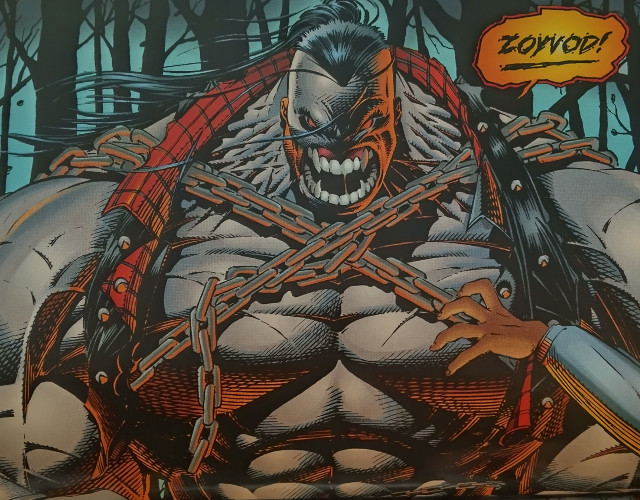
Dale Keown, it's fair to say, is principally known for, if not his Image Comics creation, his collaboration on the Incredible Hulk with Peter David. He's illustrated the gamma-grown goliath in both his gray and green forms, providing a style that emphasizes the raw girth and power of the character. Muscles bulge, tendons in the neck strain, veins snake along biceps and forearms. Keown's Hulk is not the mindless, shambling Frankenstein of a monster originally pictured by Jack Kirby. When powered by the intelligence of Bruce Banner, Keown's Hulk is a downright terrifying juggernaut, a WWE wrestler crossed with a nuclear scientist stretched to 7 feet tall.
That same raw ferocity is found in Pitt, and for any fan of Keown, you will be reading this volume primarily to see how Keown's experience at Marvel translates over to this Image series. There's not a ton of difference, physically, between Pitt and the Hulk: they're huge, gray, rippling with muscles. You get the sense, from these early issues, that Keown just wanted to keep drawing really big dudes and brought over his most famous Marvel contribution without worrying about copyright infringement, giving the Hulk an appropriately violent Image "twist."
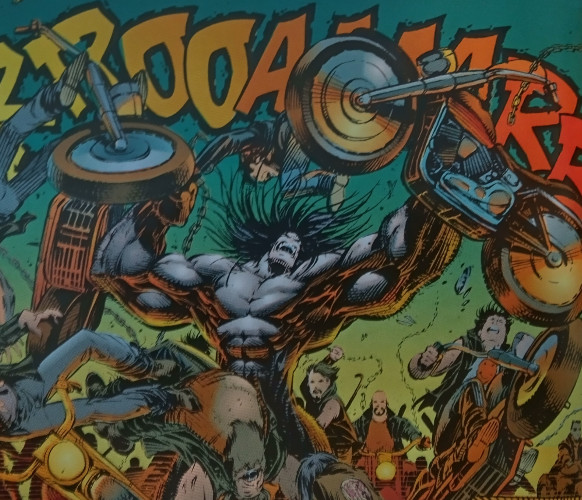
Unfortunately, "big, murderous gray guy" isn't much of a story arc, so Keown (and writer Brian Hotton) must develop a narrative around why we want to read a totally different comic about a giant dude who obliterates stuff. As noted in my other reviews, I understand I'm basing my impressions of the story on the earliest issues provided. And, as also noted about different stories in my other reviews, the core concept of Pitt is a mixed bag. Keown and Hotten develop Pitt as an alien assassin, mentally linked to an energy being named Jareeb that sorta, kinda serves as Pitt's conscience, who arrives on Earth and becomes inextricably tethered to a boy named Tommy.
There's a narrative developing here, one doled out in small sequences, just enough to keep you intrigued. Why is this energy being linked to Pitt? What is his connection to Tommy? Why does Detective Bobbie Harras (named, as noted in this volume's introduction, after Marvel editor Bobbie Chase…and also, I assume, former Marvel editor-in-chief Bob Harras?) exhibit superhuman strength? The questions propel the story forward, and they're certainly enigmatic enough to fuel interest in these chapters as they unfold. Unfortunately, as intriguing as the questions are, they carry the tremendous burden of filling in for some languishing components.
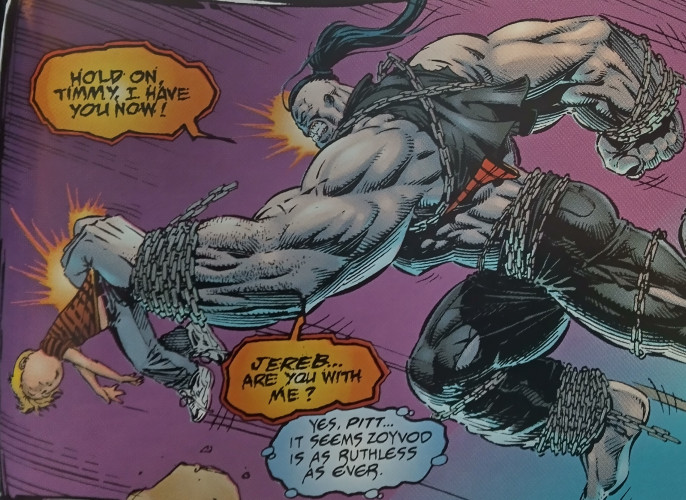
Pitt, as he is presented here, is little more than a muscle-bound goon. He's boisterous for someone who's supposed to be an assassin, careening around on a motorcycle, stopping bank robbers by ripping into their getaway vehicle, and bursting through houses. We do get a sense he's driven by a certain set of morals–he’s protective of Timmy, saving his life three times, and rescues a hostage from the bank robbers. Pitt's certainly not driven by rage and is more thoughtful than the Hulk (at most times), but he doesn't come across as fully developed or well-rounded.
At the end of the ½ issue, Pitt notes he's going to "need time to adjust" to Earth and is "going to have problems fitting in," which made me wonder if Keown and Hutton would focus on Pitt attempting to navigate the realities of living on Earth. The answer is "not really." He wears some biker duds and drives a motorcycle, but that's it. He gets attacked by a random biker gang, harasses some random hunters in the woods. If he'd picked a fight in a bar while trying to figure out the Earth custom of social drinking or bought some clothes at a Big’N’Tall or stayed in a seedy motel, I'd have felt more connected to him. If we could see the steps Pitt takes to acclimate to Earth (as well as one can when you're a Hulk-sized version of Lobo), I'd be more interested in watching his story grow. Heck, Silvestri's Cyberforce had him lounging around a gas station–that's at least something!
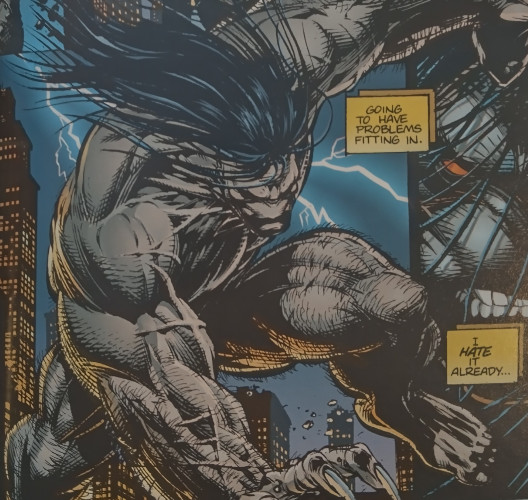
The introduction of Jareeb, I had hoped, would offer some character development; I imagined Jareeb serving a similar function to the computer in Deathlok's brain, someone who could provide opposing viewpoints and act as somewhat of a Jiminy Cricket character. Jareeb, at least in these issues, fails to fill that function, offering little more than exposition to hint at backstory we don't yet know or offer direction so Pitt can smash something else. At least at this stage in the series, we're not meant to juxtapose Jareeb's more cerebral outlook with Pitt's aggression and hands-on approach to solving problems.
Timmy, too, is offered little beyond his introduction. He's fast-tracked into "important supporting character" mode, and though his role offers the possibility of interesting growth across future stories, he's somewhat limited here. He lives with his grandfather, his parents are dead, he's got some funky connection to Pitt…but other than the fact he's a child we don’t want to see get hurt, we can't connect very much with him.

Things happen in Pitt. Or we're told things happen. And we are asked, by Keown and Hutton, to embrace the story and characters simply because these things happen. You want to cheer Pitt on because he's a great big monster who smashes things, not because he's a great big monster who smashes things who also happens to struggle with his current circumstances and attends culinary school when he isn't slicing and dicing his enemies. Look at the way he can take out a biker gang! Crush the hands of bank robbers! Rip through alien assassins! Character what? Identity what? Personal arc what? I can’t hear you over the sound of Pitt's dying enemies.
And the same is true for Tommy. I see the appeal of juxtaposing this giant monster with a young man–you appreciate the idea of someone so massive and murderous protecting someone so small and helpless. A scene near the end displays that Tommy is, maybe, not quite as helpless as we originally believed, with Keown and Hutton decently maintaining his childlike tone during a surprisingly violent moment. You get the sense this kid has been caught up in a bigger, darker world than he realized and, just maybe, the roided-out alien assassin could offer him some guidance. Maybe that happens in future issues? I don't know. But because we know so little of Timmy, the moment where he suddenly becomes more deeply connected to the story washes over real quick.
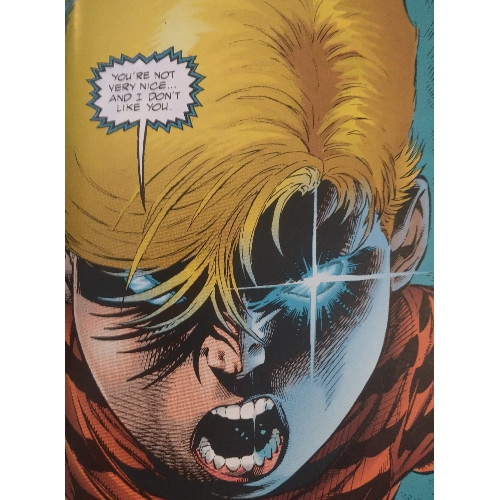
The art becomes the focal point of the volume, holding even the thinnest strands of story together. I've enjoyed the art from a few of the Image founders–Eric Larsen and Jim Valentino–but there's a cleanliness to how Keown pencils his characters which makes him stand out. Pitt is terrifying in whatever panel he pops up with, his size matched with a frighteningly toothy grin. Keown straddles this bizarre line that accentuates the violence just enough without feeling like he's going overboard, a somewhat awkward position other Image creators found themselves in as they tried pushing the envelope while staying within certain parameters. Pitt crushes a hand without us seeing the horrendous aftermath, heals from wounds to his face, and bludgeons a whole bunch of folks. We get just enough to imagine the gristle left behind without being steered into slasher movie territory.
So here we have another monster, another hero, introduced to the steadily growing pantheon of Image characters. Like several other characters, Pitt is held together by the bailing wire of a household artist taking his first stabs at independent creation. We see, time and again, how these artists couldn't always translate the ideas in their heads to the panels they were filling. Pitt does have a wealth of interesting ideas–the alien voice in Pitt's brain, the enigmatic connection Pitt has with a young man, the mystery of a seemingly superhuman detective–and I know I shouldn't expect the first four (and ½) issues of a series to adequately convey all that information. But Pitt often conveys more than it needs to…and often, it's not what it should be saying…in fact, it should say less than it does and start showing us instead. Not that I expect Pitt to take culinary school; I just want him to do something more than just smash things. We've already got a big guy in the comics world who does that.